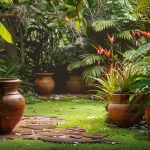Water conservation is not just a practice to be applied in certain areas; it is a lifestyle that needs to be adopted around the world. While this holds true for all regions, it is particularly significant in desert landscapes where water resources are scarce. This article will guide you on how to wisely use and conserve water in your desert home landscape. Taking into consideration various aspects such as plant selection, soil management, irrigation systems, landscape design, and more, we strive to help you create a beautiful, water-wise landscape.
The Role of Water-Wise Plants in Water Conservation
Water-wise plants are an integral part of any desert landscape. These plants are adapted to survive in settings with minimal rainfall and harsh sunlight. Incorporating such plants into your landscape design can significantly reduce your watering needs.
Cela peut vous intéresser : What's the Best Fire Safety Design for a Family Home with Young Children?
Opt for native desert plants like cacti, succulents, and desert marigolds, which have developed mechanisms to thrive in desert conditions. Also, consider adding trees like mesquite and palo verde, which provide shade and reduce evaporation.
These plants have evolved to survive on minimal rainfall, and their water efficiency reduces the need for frequent watering. Not only will this conserve precious water resources, but it will also contribute to the native biodiversity of the area.
Avez-vous vu cela : How Can You Create a Vertical Herb Garden in a Kitchen with Limited Space?
Soil Management for Enhanced Water Retention
Soil management is a crucial component of water conservation in desert landscapes. The type of soil in your garden affects water retention and nutrient absorption, which, in turn, impacts the health of your plants and the overall water usage.
Desert soil often lacks organic matter and may be sandy or clayey. This affects its ability to retain water. Adding organic matter like compost or well-rotted manure can improve soil structure and water-holding capacity. It also enriches the soil with nutrients, reducing the need for frequent watering and fertilization.
Mulching is another effective technique for soil management. A layer of mulch, whether organic or inorganic, can help reduce evaporation, suppress weeds, and moderate soil temperature.
Designing Your Landscape for Water Conservation
A well-planned landscape design can go a long way in conserving water. The placement of plants and the overall design can significantly affect water usage.
Group plants with similar water needs together. This practice, known as hydrozoning, will ensure that plants requiring more water are not placed next to those that need less, preventing overwatering and underwatering.
Additionally, consider the natural flow of water on your property. Use slopes and depressions to your advantage to create a rain garden or a bioswale. These can collect rainwater runoff and allow it to soak into the ground, reducing your irrigation needs.
Limit the area of turf in your landscape. Grass requires a lot of water to maintain, so consider alternatives like ground covers, mulch, or permeable paving.
Utilizing Efficient Irrigation Systems
The choice and management of your irrigation system play a significant role in water conservation. Drip irrigation and soaker hoses are more efficient than sprinklers since they deliver water directly to the plant roots, reducing evaporation.
The timing of watering is also crucial. Water your plants early in the morning or late in the evening to minimize evaporation. Avoid watering on windy days as the wind can carry away a significant amount of water.
Install a rain sensor or weather-based irrigation controller to adjust your watering schedule based on rainfall and weather conditions. This will prevent unnecessary watering.
Remember, overwatering is not just wasteful, but it can also harm your plants. Learn the water needs of your plants and adjust your watering schedule accordingly.
The Impact of Water Conservation
Water Conservation in a desert home landscape is not only crucial for the environment but also beneficial for you. It can reduce your water bill, make your landscape more resilient and less dependent on regular watering, and contribute to regional biodiversity.
By selecting water-wise plants, managing your soil wisely, designing your landscape for water conservation, and using efficient irrigation systems, you can create a beautiful, sustainable, and water-wise desert landscape.
Remember, every drop counts. Your efforts towards water conservation will help preserve this vital resource for future generations. For a more sustainable future, every action we take matters.
Adopting Drought-Tolerant Trees and Shrubs for a Low Water Landscape
Making wise choices in your plant selection can greatly influence your landscape’s water consumption. Opting for drought-tolerant trees and shrubs is a smart decision when living in an arid climate like the Arizona desert.
Trees such as the Blue Palo Verde and the Ironwood are excellent choices as they are native to desert regions and are naturally drought-tolerant. These trees have deep root systems that seek out water, making them highly water-efficient. Shrubs such as the Yellow Bells and Red Bird of Paradise are equally efficient, having adapted to thrive in low water conditions.
These drought-tolerant trees and shrubs not only contribute to the aesthetic appeal of your landscape but also help create a more sustainable environment by reducing the amount of water needed for maintenance. Moreover, they provide habitat to local wildlife, thus promoting biodiversity.
By incorporating these plants into your landscape design, you are effectively adopting a water smart lifestyle that appreciates and respects the scarcity of water resources in desert environments.
Creating a Landscape Watering Guide for Your Plants
Having a landscape watering guide for your plants is a crucial aspect of water conservation. This guide should be tailored to the specific water needs of your plants, taking into account the type of plant, its growth stage, and the season.
Water-efficient plants require different amounts of water at different stages of their growth. For instance, while a newly planted desert marigold may require watering every other day, an established one needs watering only once a month.
Creating a watering guide helps ensure that you water your plants wisely, providing just enough to keep them healthy without overwatering. Overwatering not only leads to water wastage but can also result in plant diseases due to waterlogged roots.
Bear in mind that your watering guide should also consider seasonal variations. For instance, during the hot summer months, your plants may require more frequent watering compared to the cooler months.
Conclusion: Fostering a Water-Wise Lifestyle
Water conservation is an essential part of maintaining a desert home landscape. Adopting water-wise practices in your landscaping choices, from the selection of drought-tolerant trees and shrubs, soil management, design considerations, and efficient irrigation systems, significantly reduces water consumption.
By choosing water-efficient plants, managing your irrigation system wisely, and developing a landscape watering guide, you are not just conserving water but also creating a resilient and aesthetically pleasing landscape that is in harmony with the Arizona desert environment.
Remember, your commitment to a water-wise lifestyle benefits not only you but also the larger ecosystem. Your efforts towards water conservation contribute to preserving our water resources and creating a more sustainable future. Every action we take, however small, can make a significant difference. Therefore, let us all strive to use water wisely and value every drop.











